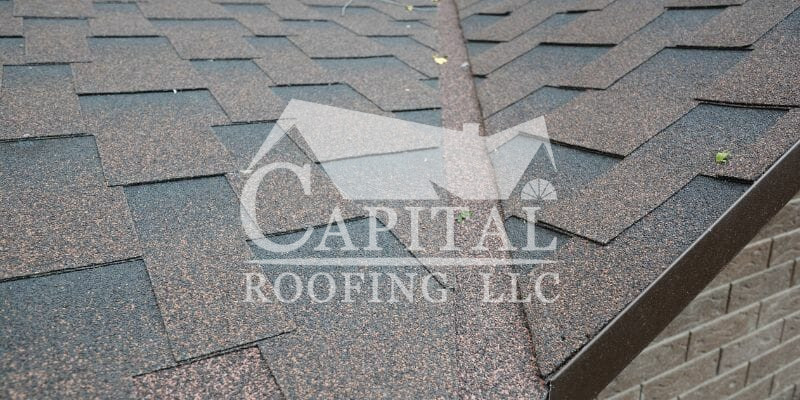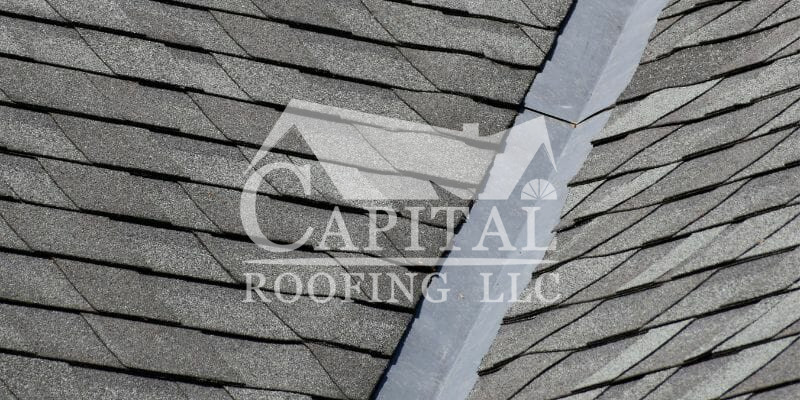Choosing the shingle color is a fun and interesting part of a roof replacement project, and homeowners often give less thought to a roof valley. But the truth is, choosing the right type of valley can significantly affect your roof’s overall performance. When you start to research this topic, there are many different opinions, enough to confuse anyone!
So to help, we are here with our expert guide for all homeowners. At Capital Roofing, we’ve been building the most sturdy, durable, and appealing roofs for years! We understand how important it is that you have a safe and beautiful home. That’s why our experts are here to help you make the best choices possible.
In this article, we will explain everything about roof valleys– from closed and open valleys to cost and maintenance tips– Here’s everything homeowners should know about roof valleys:
What Is a Roof Valley?
A roof valley is an area where two sloping roofs meet. It’s the space between two sloping roof planes that meet at the lowest point of the roof. The role of a roof valley is to channel the rainwater straight into the gutters. There are two major types of roof valleys– open valley and closed valley. When you need to repair or replace your roof, you must choose the right kind of valley system.
Closed Valley Roofing System
A closed valley roof is one where the shingles are woven together to create a closed space, which is not covered by additional waterproofing and safety materials. This type of roof valley costs less than an open valley system.
However, there are many reasons why the experts do not recommend this style:
- It does not adequately protect against harsh weather conditions such as high winds, heavy rains, ice dams, and snow storms.
- Closed valley shingles are susceptible to damage by moisture and hail. They are prone to leaks, blocks, and withering.
- A closed valley generally needs to be repaired or replaced more frequently.

Open Valley Roofing System
An open roof valley is not covered by shingles. Instead, it is completely sealed using waterproof and sturdy metal flashing. Open valleys are the most common type of valleys in homes today because they offer higher sealing and waterproofing for your home.
- Open valley systems are more flexible and can be adapted to fit a variety of roofing systems.
- They’re easier to install because you don’t have to weave, cut, and remove the shingles, which can save you time and money.
- The open valleys avoid shingle damage, which makes them more durable long term.
- Open valleys help prevent roof leaks in heavy rain, which means less money is spent on repairs down the road! All of this makes them more cost-effective than closed valleys in the long run.
There are different types of flashing materials available to seal open valleys. When choosing a flashing material, make sure it fits well with your roof’s aesthetics and is sturdy enough to handle your local weather for years! Below are the most common flashing materials for roof valleys:

Roof Valley Flashing Materials
Metal strips are widely used to create tight, waterproof, and insulated roof valleys. The most common metals for roof flashing are– coated steel, aluminum, and copper.
Coated Steel
It is the first choice of homeowners who are looking for an affordable option. Since steel can corrode over time, your roofing contractor will have to coat it with additional materials such as stone, copper, zinc, and aluminum.
Aluminum
An effective alternative to steel, aluminum can be more expensive than steel—though you may be able to find recycled or reclaimed pieces that are priced more affordably than new ones would be! Aluminum is naturally free from rust, making it an excellent choice for roof flashing material. If you live in a coastal region or near a saltwater lake, aluminum can be the best choice as it doesn’t corrode by salts.
Copper
Copper might be what you need if you’re looking for both beauty and functionality! It doesn’t rust or corrode, and instead, its surface develops a patina over time that makes each piece unique and beautiful in its own way. The shiny blue-green color protects the copper flashing against any corrosion.
When you’ve chosen the correct type of roof valley system, there’s just one more thing you need to take care of– it’s maintenance. There are specific issues common with roof valleys, but you can easily prevent them from happening if you know what to do.
Issues With Roof Valleys
Roof valleys are necessary because the roof slope angle is not perfectly vertical, and it’s also important that water can drain from the roof to prevent ponding, which can lead to severe structural damage.
However, there are some issues associated with roof valleys that homeowners should be aware of:
- Roof valleys are prone to leaks if they aren’t correctly installed or maintained.
- When you think about quick fixes, they can be challenging to access and maintain.
- They can also be challenging to insulate. Adding insulation in these areas will require more labor and materials than would generally be needed elsewhere on a house’s exterior walls or ceilings.
That’s why you must keep an eye on your roof valleys and choose a reliable roofing contractor to install your roof flashing. Here are some tips on how to prevent issues with your roof valley:
How To Avoid Problems With Roof Valleys
Keep the roof clean: The first step in preventing water damage is to keep debris out of your roof valleys. Debris such as twigs, pebbles, leaves, or pine needles, can clog the gutter system and cause water to leak into your attic. If you have an open valley, install gutter guards that filter large particles like leaves. Call a roofing contractor once a year to inspect and clean your roof.
Use proper attic insulation: Heat loss through roof valleys accounts for about 10 percent of heat loss in a home before winter sets in! One way to reduce this is by installing attic insulation beneath your rafters. Carefully insulate the area where there’s a valley. Check with a good roofing contractor before proceeding with this step to ensure adequate ventilation while ensuring minimal condensation buildup due to improper installation.
If you want to learn more about roof valley systems or need help installing the best roof valley system, we are here to help you.
Which Is The Right Type Of Roof Valley For Your Home?
With so many options available, it can be tricky to choose based on others’ perspectives and experiences. Every home is unique, and we know you may have different needs and tastes when it comes to improving your home.
At Capital Roofing, we’ve been installing the best roofing systems in Claremore, OK., and the surrounding areas. If you want an honest and experienced roofing contractor to work on your home, we are the perfect team for you.
Call us at (918) 260-4075 for a free consultation and roof inspection. One of our experts will answer any questions about roof valleys and other parts of your roof. We always ensure our customers have a great experience, and we look forward to working with you too!

